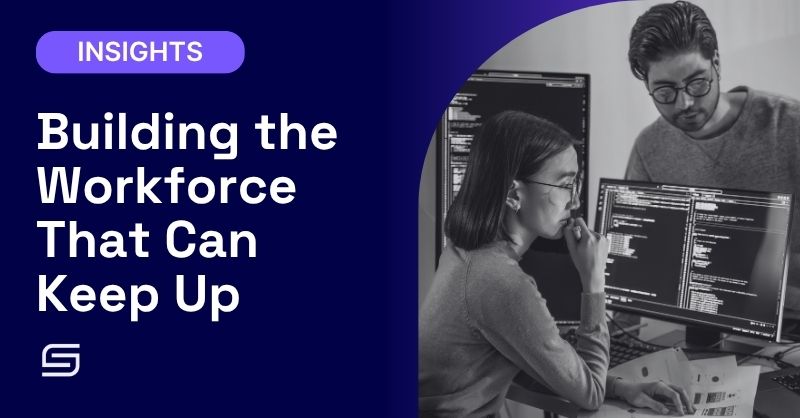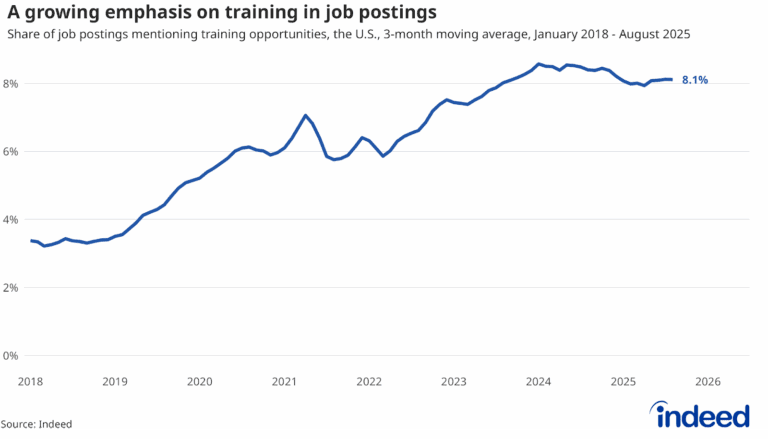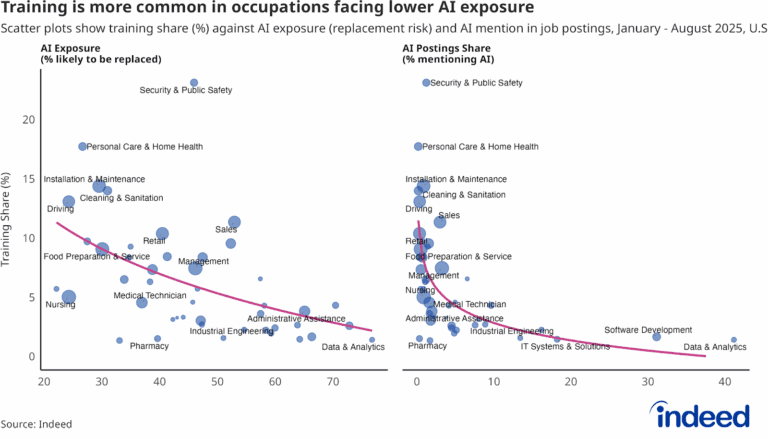Building the Workforce That Can Keep Up

The jobs most exposed to AI are the least likely to offer training. That insight from Indeed’s Hiring Lab reveals more than a labor-market quirk -it exposes a readiness gap at the center of the AI economy.
While U.S. job postings that mention training have more than doubled in eight years — from 3.4% in 2018 to 8.1% in 2025 -the increase isn’t evenly distributed. The majority of training opportunities are clustered in lower-wage, lower-education, and lower-AI-exposure roles.
Meanwhile, the very roles being redefined by AI – software engineers, data scientists, system architects – are the least likely to offer structured learning opportunities. It’s a paradox of progress: the jobs reshaping the future of work are the ones least equipped to evolve with it.

Employer-provided training has become more visible in recent years, rising from 3.4% of job postings in 2018 to 8.1% in 2025 – a 2.4x increase over eight years.
Source: Indeed Hiring Lab, 2025. Source: Indeed Hiring Labs Oct 2025
The Real Gap Isn’t Skills. It’s Readiness.
Most organizations are modernizing their codebases faster than their cognitive bases.
They invest in the tools of AI, but not the people who will determine whether those tools succeed.
Traditional corporate learning was built for predictability: learn a platform, apply it for years, update occasionally. AI shattered that rhythm. It demands learning that’s continuous, contextual, and embedded directly into the flow of work.
AI readiness isn’t about knowing how to use new tools; it’s about understanding how to think in the logic of AI systems – where human judgment, governance, and machine intelligence must work in tandem.
Training opportunities decline as AI exposure and adoption increase — meaning the workers most affected by AI transformation often receive the least structured development. Source: Indeed Hiring Lab, 2025.
Why Conventional Training Falls Short
The data tells a clear story: training is growing, but not where it matters most.
Across the labor market, structured learning opportunities cluster in lower-exposure, lower-wage roles – while high-exposure technical fields like software development and data engineering show far fewer. In other words, the workforce building the AI economy is often the least supported in adapting to it. That imbalance is widening the divide between adoption and readiness -a gap every enterprise will eventually have to confront.
For decades, early-career engineers learned through repetition – debugging, testing, refactoring – the hands-on work that built both skill and judgment. Now, many of those foundational tasks have been automated away. The first rung of the career ladder has disappeared, taking with it the organic apprenticeship model that once produced system-level thinkers.
At the same time, experience requirements in technical roles have continued to rise. Fewer entry-level opportunities, combined with higher bars for experience, are creating a bottleneck for emerging talent – the very pipeline enterprises depend on to sustain innovation.
Most learning models today still teach execution, not orchestration. They focus on tools and completion rather than context and capability. They produce operators who can use AI, but not professionals who can guide it – leaving organizations with powerful technology but a workforce unprepared to sustain it.
From Skills to Systems: Redefining Readiness
The solution isn’t more training. It’s different training. AI has changed the nature of work itself — shifting from task execution to system orchestration. To keep up, organizations must evolve the way people learn, practice, and grow inside intelligent environments.
At Smoothstack, readiness begins where traditional training stops. We develop engineers, developers, and data professionals who can design, deploy, and scale intelligent systems responsibly – blending technical fluency with architectural thinking, governance, and real-world context.
That means treating AI as an apprentice – fast, tireless, but naïve — and teaching humans how to guide it. It means learning in mirrored environments that reflect how enterprise systems actually operate, with the same focus on security, compliance, and performance that live production demands. And it means cultivating a mindset where reliability and governance are not separate stages of development – they’re part of how modern engineers think from the start.
This is readiness redefined:
- Continuous, not episodic: learning that evolves with every release.
- Contextual, not tool-based: built around how AI integrates into real systems.
- Collaborative, not siloed: uniting human judgment with machine capability.
- Architectural, not tactical: designed for scale, security, and reliability.
- Governed, not improvised: where structure accelerates creativity.
- Enterprise-ready by design: being AI-ready means thinking in systems, anticipating risk, and building with intelligence from the start.
We don’t just prepare people to use AI. We prepare them to work natively within it — turning fast output into sustainable capability.
The Workforce Multiplier
When readiness evolves at the pace of technology, innovation compounds.
That’s the multiplier effect – not from adding more people, but from elevating what teams are capable of together.
Smoothstack helps enterprises achieve exponential output without exponential headcount – building AI-ready teams that think architecturally, work collaboratively, and design with governance and scale in mind.
Our engineers don’t just adapt to new technologies -they anticipate them. They turn disruption into design. They translate AI from experimentation into execution.
Because AI runs on code. Code runs on people. And people need context. Being AI-ready is the new enterprise-ready – the standard for organizations built to last.
Building What Comes Next
Every breakthrough in AI still begins with people — the ones designing the systems, guiding the models, and keeping intelligence accountable. Technology may accelerate progress, but people give it purpose.
The organizations that lead won’t just automate faster; they’ll learn faster, build smarter, and scale responsibly. They’ll power what’s next –in people, performance, and possibility.
That’s what Smoothstack builds every day. Not just what’s next in technology – but who’s next in the workforce that shapes it.
Let’s Build Your Team
Connect with the Smoothstack team to learn how to close your digital skills gap with a custom-trained team.
